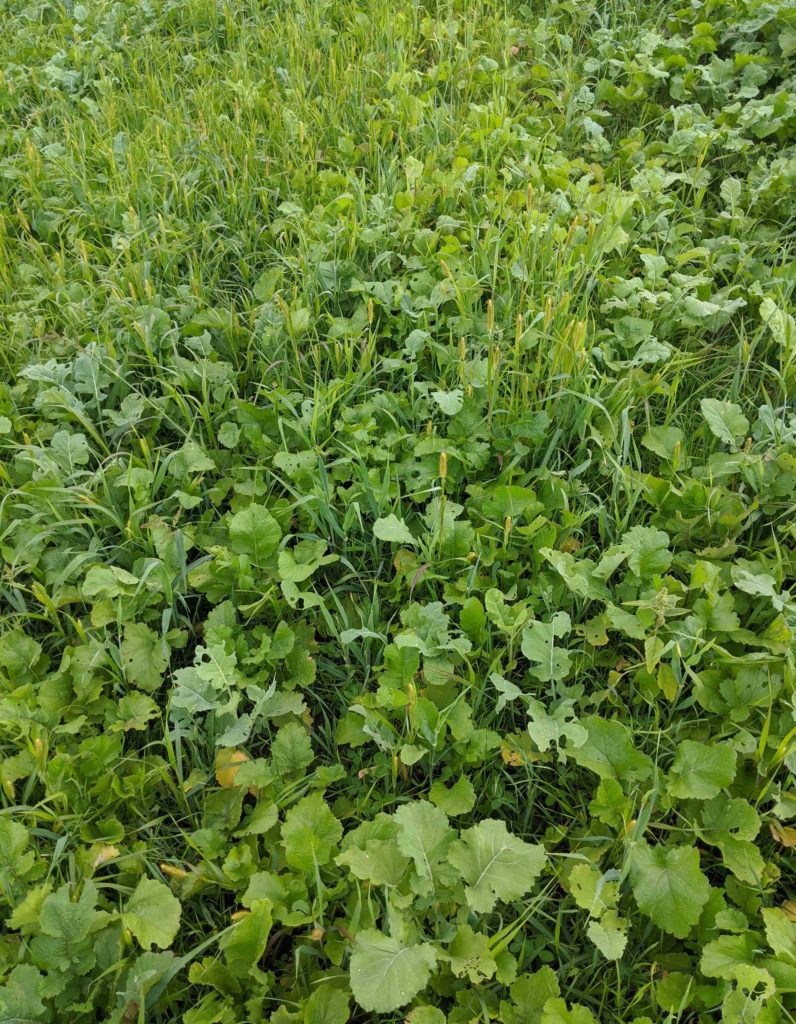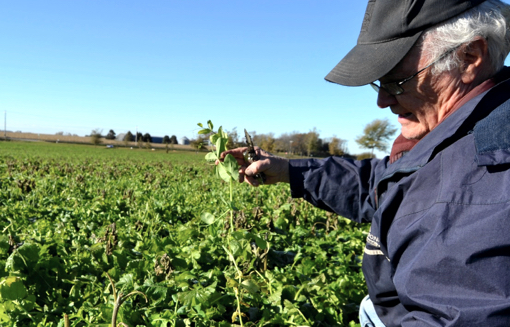Cover Crop Options after Small Grain Harvest

By Jonathan Kilpatrick • Farmer Education Director
While persistent rainfall across the state is delaying the start of small grain harvest for many farmers, this downtime can be used to plan for post-harvest cover crops. Planting cover crops immediately after harvesting small grains like wheat, barley, or oats can be highly beneficial and is a great way to take advantage of the moisture we’re getting.
Cover crops are a cornerstone of regenerative agriculture, offering numerous advantages such as:
- Improving Soil Health: By keeping a living root in the soil and maintaining soil cover.
- Biodiversity: Diversifying the species grown on every acre.
- Livestock Integration: Providing excellent grazing opportunities for livestock.
After harvesting small grains, farmers have a unique window to plant cover crops that can maximize these benefits. Here, we explore various cover crop options to consider post-harvest and how they can contribute to a more resilient farming system.
Pre-work

Before we begin designing a cover crop mix, there are two key considerations to address.
One of the most crucial aspects is understanding your resource concerns and the specific needs of your land. So, let’s identify your priorities. Is your primary goal to cover bare soil and prevent erosion from fall rains? Do you aim to build up nitrogen levels before next year’s corn crop? Or are you looking to maximize the utility of your acres by incorporating fall or winter grazing? Each of these objectives represents a resource concern or goal. By clearly identifying these priorities, we can tailor the cover crop mix to effectively meet the specific needs of your land.
Secondly, always start with the end in mind. Consider how you plan to terminate the cover crop. Cover crops planted at this time of year offer a great termination option with the onset of winter, as we can design a mix that will naturally winter-kill, allowing you to plant directly into the residue in the spring. Herbicide and tillage are also effective termination methods, while grazing provides an opportunity to harvest and cycle some of the nutrients produced by the cover crop before it is terminated.
Selecting the Right Cover Crop Species
Now, let’s talk about selecting specific cover crop species. While this article won’t provide a one-size-fits-all recipe for your cover crop mix (remember the first two points we discussed), I will outline some general principles for species selection.

Cover crop seed options can be categorized into three main plant functional groups: grasses, legumes, and broadleaves (forbs). Research from the University of Minnesota has shown that maximum biomass production occurs when at least nine species are included in a diverse mix. Since diversity is a key soil health principle, we recommend incorporating at least nine species in your cover crop mix whenever possible—three from each functional group.
Here are some guidelines to keep in mind:
- Grasses: Include options like cereal rye, oats, and annual ryegrass.
- Legumes: Consider species such as clovers, vetches, and peas.
- Forbs: Incorporate broadleaf plants like radishes, turnips, and kale.
Context is crucial. Always consider your next crop when choosing your cover crop species. For example, avoid planting cereal rye if you plan to sow spring wheat the following year, or radishes if canola is in your rotation. By carefully selecting your cover crop species, you can create a mix that meets your resource goals, increases your soil heath, and aligns with your crop rotation plans.
Planting a cover crop after your small grain harvest can be even more economical by utilizing the grain that escapes the combine. Here’s a handy method to factor that into your cover crop mix.
- Estimate Grain Left in the Field
- Place a catch pan behind the combine to collect any grain that passes through.
- Weigh the grain collected in your catch pan.
- Calculate the grain loss per acre:
- Divide 43,560 (the number of square feet in an acre) by the square feet of your catch pan.
- Multiply this result by the weight of your sample. This will give you the weight of grain lost per acre.
- Sampling and Spreading
- Combines do not distribute losses evenly, so take samples from various locations in the field to get an accurate estimate.
- Once you estimate the pounds of small grain seed already present in the field, subtract that from the amount you need to seed.
- Depending on the loss, sometimes you only need to drill a small amount of legume and brassica seed.
- Optimize Chaff Spreaders (if your combine has them)
- Set your chaff spreaders to distribute chaff as evenly as possible across the width of the header on the combine.
By incorporating these steps, you can efficiently use the residual grain in your field, reducing the need for additional seed and making your cover cropping efforts more economical.

Keys to Success with Cover Crop Mixes
- Focus on Grasses
- Cool Season Grasses: As the seasons shift, prioritize cool season grasses. Excellent options include annual ryegrass, oats, barley, triticale, and cereal rye.
- Proportion: Ensure grasses form the majority of your mix as they will provide most of the carbon that will build soil organic matter and provide armor on the soil.
- Use Brassicas Sparingly
- Seeding Rate: Limit brassicas to no more than 2 pounds per acre. Given that most brassica species have well over 100,000 seeds per pound, a small amount goes a long way.
- Grazing Considerations: When designing a mix for grazing, be mindful of the amount of brassicas and legumes to avoid the risk of livestock bloat.
- Limit Legumes:
- Seeding Rate: Use legumes, such as clovers, in moderation—typically a couple of pounds per acre is sufficient due to their small seed size.
- Balance: Avoid overloading your mix with legumes to maintain proper soil nutrient balance and prevent potential digestive issues in livestock.
While this brief article isn’t exhaustive by any means, it hopefully has provided some key principles to get you started with cover crops after a small grain harvest. For more detailed planning, we recommend using the SmartMix Calculator on the Green Cover Seed website. This open-source, free tool helps you design mixes based on your specific resource goals and provides in-depth information on the characteristics and traits of each species. By entering your top goals and next crop, the calculator suggests appropriate species to plant.
However, if you’re ever unsure, don’t hesitate to reach out to one of our consultants for tailored recommendations that work best in this region. As always, if you have any questions about cover crops or soil health, feel free to contact our team. Happy harvesting and planting!

I am interested in hearing peoples experience with atv or 3 point mounted broadcast seeders. I have a pendulum seeder that is reasonably accurate with small grains but inconsistent with small seeds. Even with mixing small batches of small seeds and oats the small seeds are not evenly distributed.